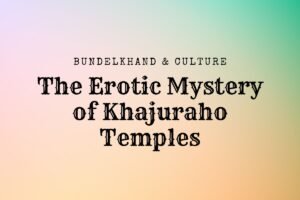Orchha, a small town in Madhya Pradesh, is a place rich in history, culture, and heritage. For centuries, it has been a hub of art, spirituality, and commerce, attracting visitors from far and wide. If you’re a history buff or just looking for a peaceful escape, Orcha is the perfect destination.
In this blog, we’ll take a journey through time and discover the fascinating history of this quaint town. From its glory days as a flourishing kingdom to its decline under the British Raj, Orcha has a rich and varied past that’s just waiting to be explored.
The Rise of Orchha- History of Orchha
Orchha’s history can be traced back to the 16th century when it was ruled by the Rajput rulers. The town’s most famous ruler was Raja Rudra Pratap Singh, who came to power in the late 16th century. He was a visionary leader who transformed Orcha into a center of power and prosperity.
Under Raja Rudra Pratap Singh’s rule, Orcha flourished. He built several grand palaces and monumental structures that still stand today, including the Jehangir Mahal, a magnificent palace that was built in honor of Emperor Jahangir. The Jehangir Mahal is considered one of the finest examples of Rajput architecture and is a must-visit for anyone visiting Orcha.
In addition to the Jehangir Mahal, Raja Rudra Pratap Singh also built several other magnificent structures, including temples, gardens, and bathhouses. These structures were not only practical, but they also served as a symbol of the Rajput’s power and wealth. Orcha became a hub of art, culture, and spirituality, attracting scholars, artists, and pilgrims from far and wide.
The Fall of Orchha – History of Orchha
Orchha’s golden age was not to last. In the early 17th century, the Mughal Empire began to expand, and Orcha came under attack. In 1635, Emperor Jahangir laid siege to the town, causing much destruction. The town was sacked, and many of its buildings were left in ruins.
The Resilience of Orchha – History of Orchha
Despite this setback, Orcha did not give up. Under the rule of Raja Indramani, the town once again rose from the ashes and became a hub of trade and commerce. He reconstructed many of the town’s buildings and made it a hub of activity once again. He built several new temples, including the Laxmi Narayan Temple, which is still considered one of the finest examples of Hindu architecture in the region.
Orchha saw a revival of its cultural and spiritual significance, as people once again flocked to the town to marvel at its stunning temples and palaces. It became a place of pilgrimage for Hindus and a center of learning for scholars and mystics.
The Decline of Orchha – History of Orchha
In the 19th century, Orchha became part of the British Raj, and its cultural and economic significance declined. The British saw Orcha as a backward and unimportant town, and they made few efforts to preserve its rich heritage. The town became a backwater, and many of its grand structures fell into disrepair.
Despite its decline, Orcha still holds onto its rich heritage. The town remains a popular tourist destination, attracting visitors who are interested in history, architecture, and spirituality. Many of the town’s magnificent structures have been restored, and visitors can now explore Orchha’s rich past and appreciate its cultural heritage.
The Present-Day Orchha – History of Orchha
Today, Orcha is a quiet and peaceful town surrounded by rolling hills and lush forests. It offers a glimpse into India’s rich past and serves as a testament to the resilience of its people and their cultural heritage. Whether you’re a history buff or just looking for a peaceful getaway, Orcha is definitely worth a visit.
The Rich Heritage of Orchha
One of the most striking features of Orcha is its temples, which are a fusion of Hindu and Islamic architecture. The Laxmi Narayan Temple, for example, has intricate carvings and sculptures that depict scenes from Hindu mythology. The temple’s facade is adorned with intricate carvings and sculptures that showcase the skill and creativity of the artists who created them. The interiors of the temple are no less impressive, with elaborate paintings and murals that depict scenes from Hindu mythology.
The town also has several palaces, including the Jehangir Mahal, which was built by Raja Rudra Pratap Singh in the 16th century. The Jehangir Mahal is a grand palace that showcases the wealth and power of the Rajput era. The palace is a fusion of Hindu and Islamic architectural styles, with intricate carvings and sculptures adorning its walls and ceilings. The palace’s interiors are equally impressive, with intricate frescoes and murals that depict scenes from Hindu mythology and everyday life in the Rajput era.




